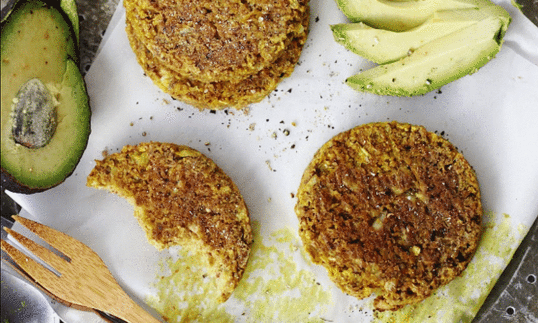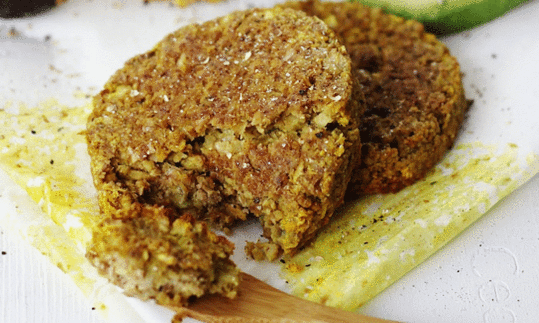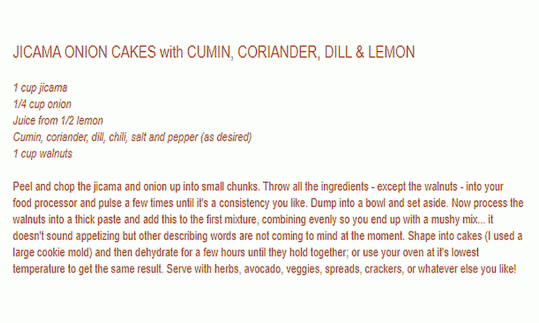Raw Jicama Onion Patties with Cumin and Coriander
raw-vegan
Ingredients (for servings, )
| For the jicama patties | |
|---|---|
| 1 cup | Yam beans (tuber bean, jícama, benkuang), raw, organic? (4.6 oz) |
| ½ | Lemons, raw (limes, organic?) (1.0 oz) |
| ¼ cup, chopped | Onions, raw (organic?) (1.4 oz) |
| 1 dash | Cumin, ground (raw, organic?) (0.00 oz) |
| 1 dash | Real coriander, seeds (raw?, organic?) (0.01 oz) |
| 1 sprigs | Dill, raw (herb, seeds, organic?) (0.01 oz) |
| 1 dash | Chili powder (raw?, organic?) (0.01 oz) |
| 1 dash | Black pepper (organic?, raw?) (0.00 oz) |
| 1 dash | Table salt (table salt, raw?, organic?) (0.01 oz) |
| ½ cup, chopped | Walnuts (tree nuts), raw (organic?) (2.1 oz) |
Equipment
- food processor or shredder
- dehydrator
- vegetable peeler
- citrus juicer (lemon squeezer)
Type of preparation
- dehydrate
- chop or grind
- food preparation without heating
- blend
- squeeze
- season to taste
- peel
Preparation
For the jicama patties
Peel the jicama and chop it into small pieces. Squeeze the lemon. Add all the remaining ingredients except the walnuts and puree in a blender until smooth (but not too fine). Pour into a bowl and set aside.The original recipe does not specify the amounts of cumin, coriander seeds, dill, chili, salt and pepper. Use the spices according to your taste. If you have fresh spices, these are preferable.
Puree the walnuts in a food processor until they form a thick paste. Add the nut paste to the jicama mixture and mix evenly.
Form the mixture into patties with your hands or with the help of a large cookie cutter.
drying patties
Dry in the dehydrator for about 5 hours or longer (until they hold together). Alternatively, you can dry the patties in the oven at the lowest temperature.Unfortunately, the original recipe doesn't specify drying times. It's best to check the consistency every 2-3 hours.
Serve
Serve with salad or as a burger with herbs, avocado, vegetables and spreads, or as desired.Raw Sunday rolls or spelt bread are suitable as burger bread.
|
Nutritional Information per person
Convert per 100g
|
2000 kcal | |
|---|---|---|
| Energy | 229 kcal | 11.5% |
| Fat/Lipids | 19 g | 27.5% |
| Saturated Fats | 1.8 g | 9.1% |
| Carbohydrates (inc.dietary fiber) | 13 g | 4.9% |
| Sugars | 3.2 g | 3.5% |
| Fiber | 6.0 g | 23.9% |
| Protein/Albumin | 5.3 g | 10.7% |
| Cooking Salt (Na:84.5 mg) | 215 mg | 8.9% |
| Essential micronutrients with the highest proportions | per person | 2000 kcal | |
|---|---|---|---|
| Fat | Alpha-Linolenic acid; ALA; 18:3 omega-3 | 2.7 g | 134.0% |
| Fat | Linoleic acid; LA; 18:2 omega-6 | 11 g | 112.0% |
| Min | Manganese, Mn | 1.1 mg | 54.0% |
| Min | Copper, Cu | 0.51 mg | 51.0% |
| Vit | Vitamin C (ascorbic acid) | 23 mg | 28.0% |
| Vit | Biotin (ex vitamin B7, H) | 11 µg | 23.0% |
| Prot | Tryptophan (Trp, W) | 0.05 g | 21.0% |
| Prot | Threonine (Thr, T) | 0.19 g | 21.0% |
| Vit | Folate, as the active form of folic acid (née vitamin B9 and | 42 µg | 21.0% |
| Elem | Phosphorus, P | 122 mg | 17.0% |
Detailed Nutritional Information per Person for this Recipe
The majority of the nutritional information comes from the USDA (US Department of Agriculture). This means that the information for natural products is often incomplete or only given within broader categories, whereas in most cases products made from these have more complete information displayed.
If we take flaxseed, for example, the important essential amino acid ALA (omega-3) is only included in an overarching category whereas for flaxseed oil ALA is listed specifically. In time, we will be able to change this, but it will require a lot of work. An “i” appears behind ingredients that have been adjusted and an explanation appears when you hover over this symbol.
For Erb Muesli, the original calculations resulted in 48 % of the daily requirement of ALA — but with the correction, we see that the muesli actually covers >100 % of the necessary recommendation for the omega-3 fatty acid ALA. Our goal is to eventually be able to compare the nutritional value of our recipes with those that are used in conventional western lifestyles.
| Essential fatty acids | per person | 2000 kcal |
|---|---|---|
| Alpha-Linolenic acid; ALA; 18:3 omega-3 | 2.7 g | 134.0% |
| Linoleic acid; LA; 18:2 omega-6 | 11 g | 112.0% |
| Essential amino acids | per person | 2000 kcal |
|---|---|---|
| Tryptophan (Trp, W) | 0.05 g | 21.0% |
| Threonine (Thr, T) | 0.19 g | 21.0% |
| Isoleucine (Ile, I) | 0.20 g | 16.0% |
| Leucine (Leu, L) | 0.36 g | 15.0% |
| Phenylalanine (Phe, F) | 0.22 g | 15.0% |
| Valine (Val, V) | 0.24 g | 15.0% |
| Lysine (Lys, K) | 0.15 g | 8.0% |
| Methionine (Met, M) | 0.07 g | 8.0% |
| Vitamins | per person | 2000 kcal |
|---|---|---|
| Vitamin C (ascorbic acid) | 23 mg | 28.0% |
| Biotin (ex vitamin B7, H) | 11 µg | 23.0% |
| Folate, as the active form of folic acid (née vitamin B9 and | 42 µg | 21.0% |
| Vitamin B6 (pyridoxine) | 0.22 mg | 16.0% |
| Thiamine (vitamin B1) | 0.13 mg | 12.0% |
| Riboflavin (vitamin B2) | 0.07 mg | 5.0% |
| Pantothenic acid (vitamin B5) | 0.31 mg | 5.0% |
| Vitamin E, as a-TEs | 0.56 mg | 5.0% |
| Niacin (née vitamin B3) | 0.51 mg | 3.0% |
| Vitamin K | 1.2 µg | 2.0% |
| Vitamin A, as RAE | 2.8 µg | < 0.1% |
| Essential macroelements (macronutrients) | per person | 2000 kcal |
|---|---|---|
| Phosphorus, P | 122 mg | 17.0% |
| Magnesium, Mg | 58 mg | 15.0% |
| Potassium, K | 281 mg | 14.0% |
| Sodium, Na | 85 mg | 11.0% |
| Calcium, Ca | 47 mg | 6.0% |
| Essential trace elements (micronutrients) | per person | 2000 kcal |
|---|---|---|
| Manganese, Mn | 1.1 mg | 54.0% |
| Copper, Cu | 0.51 mg | 51.0% |
| Zinc, Zn | 1.1 mg | 11.0% |
| Iron, Fe | 1.5 mg | 10.0% |
| Selenium, Se | 2.1 µg | 4.0% |
| Iod, I (Jod, J) | 1.5 µg | 1.0% |
| Fluorine, F | 0.24 µg | < 0.1% |
The raw vegan jicama onion patties with cumin, coriander, dill, lemon and walnuts can be enjoyed with salad or as a burger.
Nutrient profile: According to GDA guidelines, one portion of this recipe covers over 50% of the average daily requirement of omega-3 fatty acids and almost ¼ of that of manganese, copper and vitamin C. The ratio of omega-6 to omega-3 fatty acids is 4:1, which is below the recommended maximum ratio of 5:1. You can find out more at the following link: Vegans often eat unhealthily. Avoidable nutritional errors.
Jicama: The jicama, also known as the yam bean, occurs naturally from Mexico to South America, but was brought to Asia centuries ago. Only the flesh of the root tuber, which weighs up to 10 kg and is low in fat and protein and serves as a water reservoir, is edible (raw). The consistency is similar to that of a radish and ranges from slightly woody to juicy. The taste is a little like that of kohlrabi and is slightly earthy and sweet. The name can easily lead to confusion with the yam root, which is a different vegetable, and all but a few species of this are inedible raw.
Walnuts: In Central Europe, the real walnut ( Juglans regia) is particularly important. In addition to preparing and refining various dishes and desserts, walnuts are also used to make walnut oil. Of all known nuts, walnuts have the highest proportion of alpha-linolenic acid (ALA). They also have health benefits thanks to tocopherols (forms of vitamin E) and many macro and trace elements.
Cumin: Despite the similar name, cumin is not closely related to caraway and also differs greatly in taste. Ground cumin has a fresh and slightly spicy aroma, which it owes to the cuminaldehyde contained in the essential oil.
Coriander seeds: Coriander seeds contain 60% of the oil contained in the plant. Among others, linalool and geraniol are particularly responsible for the pleasant smell of coriander seeds, which only becomes apparent after drying.
Burger buns: The jicama patties taste particularly good with salad or as a classic burger. Raw Sunday buns or spelt bread are suitable as burger bread.
Vary the spices: You can vary the spices as you like. For example, you can add garlic or replace dill with fresh coriander.
Preparation in the oven: If you do not have a dehydrator, you can also prepare the patties in the oven at the lowest temperature. However, please note that at temperatures above 42 °C the dish can no longer be described as raw.







